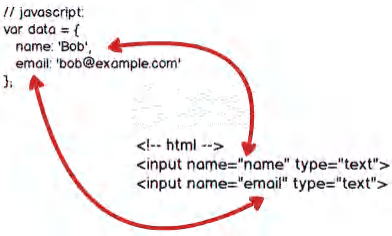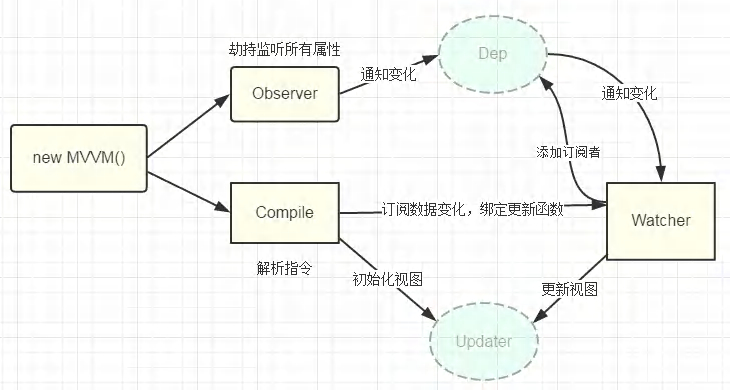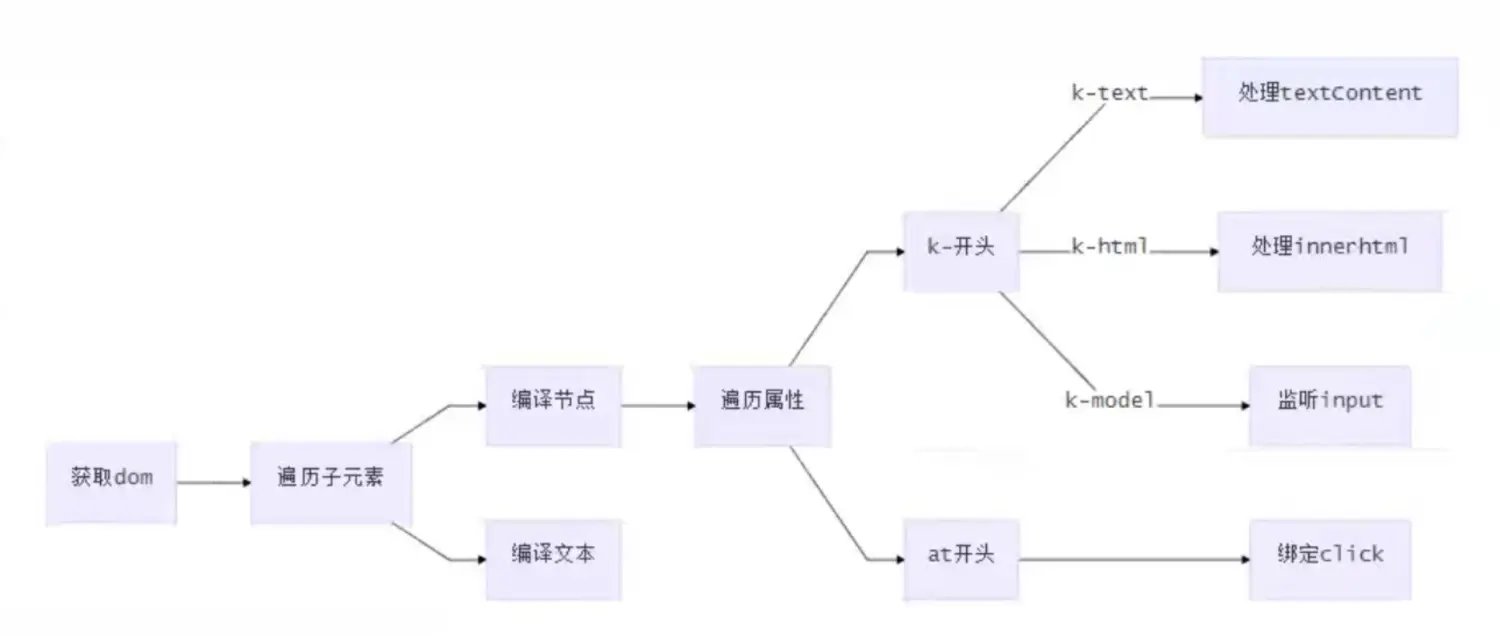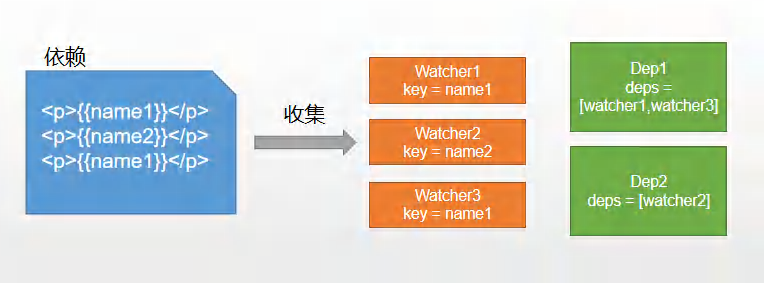双向数据绑定
什么是双向数据绑定
我们先从单向绑定切入,单向绑定非常简单,就是把Model绑定到View,当我们用Js代码更新Model时,View就会自动更新双向绑定,
在单向绑定的基础上,用户更新了View,Model的数据也自动被更新了,这种情况就是双向绑定

当用户填写表单时,View的状态就被更新了,如果此时可以自动更新Model的状态,那就相当于我们把Model和View做了双向绑定,关系图如下:

双向绑定的原理是什么
我们都知道Vue是双向数据绑定的框架,由三部分组成:
数据层(Model):应用的数据及业务逻辑
视图层(View):应用的展示效果,各类UI组件
业务逻辑层(ViewModel):框架封装的核心,它负责将数据与视图关联起来
上面的分层的架构方案,就是MVVM,核心功能就是“双向数据绑定”
理解ViewModel
主要职责:
数据变化后更新视图
视图变化后更新数据
由俩个部分组成:
监听器(Observer):对所有数据的属性进行监听
解析器(Compiler):对每个元素节点的指令进行扫描和解析,根据指令模板替换数据以及绑定相应的更新函数
实现双向绑定
我们以Vue为例,先来看下Vue中的双向流程是什么:
1、new vue()首先执行初始化,对data中定义的值执行响应化处理,这个过程发生在Observer中
2、同时对模板执行编译,找到其中动态绑定的数据,从data中获取并初始化视图,这个过程发生在Compile中
3、同时定义一个更新函数和Watcher,将来对应数据变化时Watcher会调用更新函数
4、由于data的某个key在一个视图中可能出现多次,所以每个key都需要一个管家Dep来管理多个Watcher
5、当data中定义的值发生变化,会首先找到对应的Dep,通知所有Watcher执行更新函数
流程图如下:

实现
新建Vue构造函数
对data数据进行初始化,将data代理到vm上,执行编译
class Vue {
constructor(options) {
this.$options = options;
this.$data = options.data;
// 对data选项做响应式处理
observe(this.$data);
// 代理data到vm上
proxy(this);
// 执行编译
new Compile(options.el, this);
}
}对data选项做响应式处理的具体操作
function observe(obj) {
if (typeof obj !== "object" || obj === null) {
return;
}
new Observer(obj);
}
class Observer {
constructor(value) {
this.value = value;
this.walk(value);
}
walk(obj) {
Object.keys(obj).forEach((key) => {
defineReactive(obj, key, obj[key]);
});
}
}编译Compile
对每个元素节点的指令进行扫描跟解析,根据指令模板替换数据,以及绑定相应的更新函数

class Compile {
constructor(el, vm) {
this.$vm = vm;
this.$el = document.querySelector(el); // 获取dom
if (this.$el) {
this.compile(this.$el);
}
}
compile(el) {
const childNodes = el.childNodes;
Array.from(childNodes).forEach((node) => { // 遍历子元素
if (this.isElement(node)) { // 判断是否为节点
console.log("编译元素" + node.nodeName);
} else if (this.isInterpolation(node)) {
console.log("编译插值文本" + node.textContent); // 判断是否为插值文本
{{}}
}
if (node.childNodes && node.childNodes.length > 0) { // 判断是否有子元素
this.compile(node); // 对子元素进行递归遍历
}
});
}
isElement(node) {
return node.nodeType === 1;
}
isInterpolation(node) {
return node.nodeType === 3 && /\{\{(.*)\}\}/.test(node.textContent);
}
}依赖收集
视图中会用到data中的某个key(就是data里定义的属性),这称为依赖。同一个key可能出现多次(即一个组件里多个地方调用data里的同一个属性),每次都需要收集起来并用Watcher维护,此过程称为依赖
收集。多个Watcher我们用一个Dep来管理,Dep里有俩个方法,一是收集Watcher,二是循环调用Watcher的更新方法(这是当数据改变的时候,会触发此方法)

备注
一个组件的data里定义三个属性,那就有是三个Dep,每个Dep对应一个属性,用key值区分
每个Dep里有一个或多个Watcher,Watcher的数量取决于组件里使用几次
Watcher里包含key值和对应的更新函数
实现思路:
1、defineReactive时为每一个key创建一个Dep实例
2、初始化视图时读取某个key,例如name1,创建一个watcher1
3、在创建watcher的时候,会触发name1的getter方法,这样就会将watcher1添加到name1对应的Dep中
4、当name1更新时,setter触发,便可通过对应Dep通知里面的Watcher更新
依赖收集,创建Dep实例
function defineReactive(obj, key, val) {
this.observe(val);
const dep = new Dep();
Object.defineProperty(obj, key, {
get() {
Dep.target && dep.addDep(Dep.target);// Dep.target就是Watcher的实例
return val;
},
set(newVal) {
if (newVal === val) return;
dep.notify(); // 通知dep执行更新方法
},
});
}Dep
class Dep {
constructor() {
this.deps = []; // 依赖管理
}
addDep(watcher) {
this.deps.push(watcher); // 将watcher添加到deps数组里
}
notify() {
this.deps.forEach((dep) => dep.update()); // 循环数组,调用Watcher实例里的uodate方法
}
}Watcher
class Watcher {
constructor(vm, key, updater) {
this.vm = vm
this.key = key
this.updaterFn = updater
// 创建实例时,把当前实例指定到Dep.target静态属性上
Dep.target = this
// 读一下key,触发一次依赖收集
vm[key]
// 置空
Dep.target = null
}
// 执行dom更新函数,由dep调用
update() {
this.updaterFn.call(this.vm, this.vm[this.key])
}
}简写版双向数据绑定
html
<!DOCTYPE html>
<html lang="en">
<head>
<meta charset="UTF-8">
<title>Title</title>
</head>
<body>
<div id="app">
<h3>姓名是:{{name}}</h3>
<h3>年龄是:{{age}}</h3>
<h3>info.a的值是:{{info.a}}</h3>
<div>name的值:<input type="text" v-model="name"></div>
<div>info.a的值:<input type="text" v-model="info.a"></div>
</div>
<script src="vue.js"></script>
<script>
const vm = new Vue({
el:'#app',
data:{
name:"zhangsan",
age:20,
info:{
a:'a1',
c:'c1'
}
}
})
console.log(vm)
</script>
</body>
</html>vue.js
class Vue {
constructor(options) {
this.$data = options.data
//调用数据劫持的方法
observe(this.$data);
//属性代理
Object.keys(this.$data).forEach((key)=>{
Object.defineProperty(this, key,{
enumerable:true,
configurable:true,
get() {
return this.$data[key];
},
set(newValue) {
this.$data[key] = newValue;
}
})
})
//调用模板编译
compile(options.el, this);
}
}
function observe(obj){
//使用递归给多层对象属性都添加getter,setter方法
if (!obj || typeof obj!== 'object') {
return
}
const dep = new Dep();
//通过Object.keys(obj)获取到当前obj的每个属性
Object.keys(obj).forEach((key)=>{
let value = obj[key]
//把value这个子节点进行递归
observe(value)
Object.defineProperty(obj,key,{
enumerable:true,
configurable:true,
get() {
//从watcher构造函数那里跳过来执行这里,因为那里给vm取值赋值会触发这里的函数
//Dep.target
//只要在这里执行了这一行,那么被new出来的watcher实例就被放在dep.subs数组中了
Dep.target && dep.addSub(Dep.target);
return value
},
set(newVal) {
value = newVal
observe(value);
//通知每一个订阅者
dep.notify();
}
})
})
}
/**
* 模板编译
* @param el 是option.el 这里是#app
* @param vm vue实例,就是这个this
*/
function compile(el,vm){
vm.$el = document.querySelector(el); //把这个DOM元素挂载到vm实例上
//创建文档碎片
const fragment = document.createDocumentFragment();
//把原DOM树上的所有元素都放进文档碎片中
while (childNode = vm.$el.firstChild){
fragment.append(childNode);
}
//在这里进行模板编译
modelReplace(fragment);
/**
* 定义模板编译函数
* 由于变量提升,方法提升,所以即使定义到外层,调用的时候也可以征程调用
* @param node
*/
function modelReplace(node) {
//定义一个正则表达式,匹配插值表达式
const regMustache = /\{\{\s*(\S+)\s*\}\}/;
//证明当前的节点是文本子节点,需要进行正则替换
if (node.nodeType === 3){
//文本子节点是一个DOM对象,想要获取其内容,需要调用节点的textContent属性获取
// console.log(node.textContent);
const text = node.textContent;
//进行字符串的正则匹配
const execResult = regMustache.exec(text);
// console.log(execResult)
if (execResult){
// console.log(vm[execResult[1]])
//把所有属性的值都将进行一个reduce遍历
const value = execResult[1].split('.').reduce((newObj,key)=>{
return newObj[key]}, vm);
// console.log(value);
//把通过reduce遍历得到的值赋值给node.textContent
node.textContent = text.replace(regMustache,value);
//在这里创建Watcher实例
new Watcher(vm, execResult[1],(newValue)=>{
node.textContent = text.replace(regMustache,newValue);
})
}
//终止递归条件
return;
}
//判断当前的node节点是否为INPUT输入框
if (node.nodeType === 1 && node.tagName.toUpperCase() === 'INPUT'){
// const attrs = node.attributes;
// console.log(attrs);
//把伪数组转换成真的数组
const attrs = Array.from(node.attributes);
//查找是否具备v-model这个属性
const findResult = attrs.find((value) => value.name === 'v-model');
// console.log(findResult)
if (findResult){
//获取到当前v-model的属性的值
const expStr = findResult.value
// console.log(expStr);
const value = expStr.split('.').reduce((newObj,key)=>newObj[key],vm);
// console.log(res);
node.value = value;
//创建Watcher实例,把更新的方法放在里面
new Watcher(vm, expStr,(newVal)=>{
node.value = newVal;
})
//监听文本框的输入事件,拿到文本框最新的值更新到vm上
node.addEventListener('input',(e)=>{
// console.log(e.target.value)
//通过拿到倒数第二项,然后使用[]的形式进行赋值
//对数组进行分割
const keyArr = expStr.split('.');
//slice截取数组,不包括右区间
const obj = keyArr.slice(0,keyArr.length-1).reduce((newObj,key)=>{return newObj[key]},vm);
//赋值
obj[keyArr[keyArr.length-1]] = e.target.value;
})
}
}
//不是文本节点,可能是一个DOM元素,需要进行递归处理
node.childNodes.forEach((child)=>{modelReplace(child)});
}
//把文档碎片的内容放到文档上
vm.$el.appendChild(fragment);
}
//发布者类(收集Watcher订阅者类)
class Dep {
constructor() {
//所有的watcher都被存到这个数组中
this.subs = [];
}
//往数组里面追加watcher
addSub(watcher){
this.subs.push(watcher);
}
//通知
notify(){
this.subs.forEach((watcher) => {
watcher.update()
})
}
}
class Watcher {
/**
* @param vm vm中保存着最新的数据
* @param key 在vm上众多的数据中,根据key来确定更新哪一个值,在new watcher期间,指定watcher对应的数据的名字
* @param cb 如何去更新自己
*/
constructor(vm, key, cb) {
this.vm = vm;
this.key = key;
this.cb = cb;
//在构造函数里面把watcher存到数组里面
//下面三行代码吧创建的额watcher实例存到Dep实例的subs数组中
Dep.target = this; //this就是watcher实例
//这一行代码主要是让他去触发getter方法
key.split('.').reduce((newObj,k)=>newObj[k],vm); //每一次创建实例,会在这里取一次值给vm,会触发getter
Dep.target = null;
}
//能让发布者通知我
update(){
//把新的值传给回调函数,新的值来自于this.key
const value = this.key.split('.').reduce((newObj,key) => {
return newObj[key]
}, this.vm)
this.cb(value);
}
} zhaobao1830的博客
zhaobao1830的博客